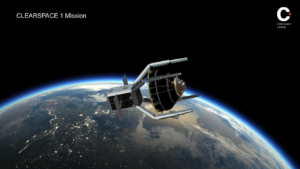OT Interviews: Five Questions With ClearSpace CSO Tim Maclay
25th Nov 2022
ClearSpace is a Switzerland-based company focused on cleaning up space, by developing an in-orbit range of services. Most recently to expand its offering, the company signed a deal with the US telecommunications company Intelsat in November to extend the life of one of Intelsat’s satellites that has run out of fuel but is functional otherwise. Tim Maclay is ClearSpace’s Chief Strategy Officer and Orbital Today sat down with Tim Maclay to discuss the company’s vision, his background in orbital debris removal, and the future of in-orbit services, such as life extension missions.
Tim Maclay, what is your background in space?
I’ve been around for a while and I am a 30-year veteran of the aerospace industry. I’m currently the Chief Strategy Officer for ClearSpace and I’ve been with them for about two and a half years. Before that, I spent most of my career in the development and launch operations of Low Earth Orbit constellations, mostly for communication purposes. I spent about four and a half years with OneWeb, and prior to that, I spent almost 20 with another constellation company called Orbcomm. My background is in astrodynamics, and I spent most of my career in one way or another dealing with orbital debris, dating back to my graduate studies when orbital debris really was just an academic topic, and it was not yet nearly the operational concern that it is today. So I have kind of lived the full experience of dealing with orbital debris environment modeling, and then as an operator dealing with collision avoidance and everything that comes with that.
How does ClearSpace fit in with the future of the space industry?
I think we’re already experiencing a real transformation in space activities. It’s gone from being dominated by governments to now really being dominated by commercial activity, and a lot of the government activities in space are even being conducted by commercial companies on their behalf. With that increase in investment and commercial activity and entrepreneurial startups, there’s really been a tremendous acceleration in the amount of stuff that we’re putting in space. That really has been a recent transformation that is paralleling some of the technical industries that happen on earth. So with a new ecosystem, a commercial ecosystem, there is a need for ancillary services or support services, and we’re really starting to see in space that there’s a transition from a ‘build it once and throw it away’ kind of industry to one where operators are really trying to optimize the utility of their assets. That, along with technological advances, is bringing this whole new wave of possible space applications called in-orbit services. So in the next 10 years, I think we’re really going to see a continuation of that transformation and the emergence of a whole host of different in-orbit services that are aimed at extending mission life, repairing satellites, optimizing the cost benefit equation for satellite operators and getting the most out of their space missions.
Could you expand on why ClearSpace partnered with Intelsat?
The types of things that are being proposed for in-orbit services span a wide range of applications. It ranges from everything from last-mile delivery, in-orbit transportation, and moving things around from one orbit to another. So we’re seeing interest in particular in disposal services, and in a form of that called active debris removal, which is removing debris from orbit that’s already defunct and derelict. There are also mission extension services, like the ones we announced with Intelsat, and in the future, there are definite plans and interests in things like in-orbit manufacturing and in-orbit assembly of really large structures. Where we’re really seeing the initial traction is, is with disposal and ADR and with the mission extension, where it’s really addressing an immediate set of needs by the operators.
We’re concentrating on providing a low-cost dedicated servicer that can be refueled and then reused, so the idea is to be able to take on multiple clients sequentially with a single service. So it’s a whole different mission architecture. If you look into it, you probably see that Northrop Grumman is going after certain classes of spacecraft, and we’re looking at a medium-sized spacecraft that our service vehicle will be specifically designed for. The other thing to mention is that I don’t think this is a ‘winner takes all’ kind of situation. There is pretty significant interest across all the GEO operators… and for GEO satellites, fuel is very often the life limiter, so if you can find a way to mitigate running out of fuel, you can extend the life of the asset and it has tremendous financial benefits.
What is the benefit of life extension services in GEO?
We’re focused on services that really provide value for the customers. You’re not going to get customers unless they want to buy them, and unless they really see value in the service, and the types of benefits that you can derive from the mission extension missions in GEO are really tangible. These folks have sunk, at times, multiple hundreds of millions of dollars into the development, launch, and operation of their assets. They’re typically designed for 15 years, and if you can extend the life of that asset, you delay the need to procure new satellites, you’ve provided continuity of your services to your customers, and you’re really maximizing the return on the existing satellite investments you’ve already made.
Lastly, what are the challenges ClearSpace has encountered so far?
I think it’s probably similar to other terrestrial industries where you’re developing a whole new technology, right? There are technical challenges and in space, those are significant, they’re not inconsequential. To be able to rendezvous remotely at a very high speed with another object and to do that robotically, to develop the technologies to either capture or dock with an object… there are a lot of technical challenges and development that need to be done initially before they can be commoditized.
New technology is expensive, and so at the beginning of this industry, you’re going to see, much like in any other industry, the first products and the first services are going to be expensive. And then as the adoption rate increases, and as the technical development is retired, you’ll see prices come down and you’ll see more of a commoditized kind of ecosystem.
The last one that’s worth mentioning is the regulatory environment. These are really new types of space missions. They’re just beginning to consider these types of applications and so there are considerations about safety, reliability and liability that I think a lot of the regulators are just beginning to grapple with. We’re seeing great support across the board, but it’s going to take a little while to kind of feel our way through the regulatory and legal frameworks that exist, both nationally and internationally.
Orbital Today would like to thank Tim Maclay for taking the time to speak with us! We hope to return for another conversation with Tim Maclay as ClearSpace progresses toward launch.






Thank you for your comment! It will be visible on the site after moderation.